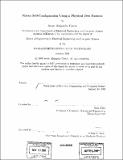Robot self-configuration using a physical test harness
Author(s)
Castro, Javier Alejandro
DownloadFull printable version (9.086Mb)
Other Contributors
Massachusetts Institute of Technology. Dept. of Electrical Engineering and Computer Science.
Advisor
Seth Teller.
Terms of use
Metadata
Show full item recordAbstract
Robot control software packages require a configuration step prior to use. The configuration requires that robot parameters such as the dimensions of the robot, the radius of its wheels, and the location of sensors in body coordinates be provided to the system. Typically, this is accomplished through manual measurement. This thesis describes a method for automating the configuration of essential robot parameters - specifically the size of the wheel radii, the dimensions of the chassis, and the location of the wheelbase with respect to the body frame and compares the results of a preliminary configuration system for the CARMEN robot navigation toolkit to the parameters determined via user measurement. The method is able to estimate the parameters of morphologically analogous robots, for which the shape and sensor types are given, through the use of a physical test harness. The targeted family of robots consists of rectangular, two-wheeled, differential drive robots that are equipped with quadrature phase encoders and current-sensing capabilities. Parameters are discovered by placing the robot in a known physical environment and moving it throughout the enclosed area, performing experiments from which each of the parameters can be calculated. The resulting self-configured parameters are then compared quantitatively to user-measured parameters through several methods including a complete system comparison using the University of Michigan Benchmark (UMBmark) as the standard for comparison. The results demonstrate that while the self-configured parameters do not match user-measured values perfectly, the proposed method remains an adequate technique for automating the configuration of microbot-class robots for use with robotics toolkits.
Description
Thesis (M. Eng.)--Massachusetts Institute of Technology, Dept. of Electrical Engineering and Computer Science, 2008. Includes bibliographical references (leaves 101-102).
Date issued
2008Department
Massachusetts Institute of Technology. Department of Electrical Engineering and Computer SciencePublisher
Massachusetts Institute of Technology
Keywords
Electrical Engineering and Computer Science.